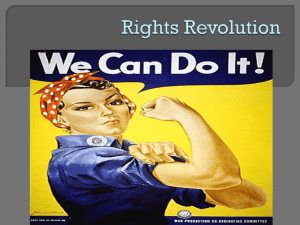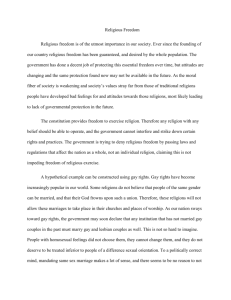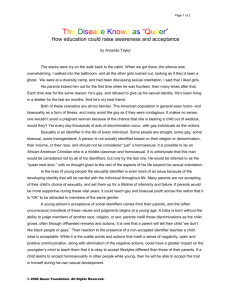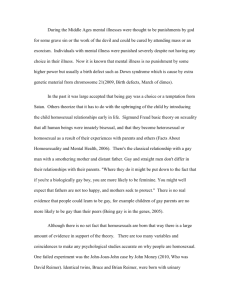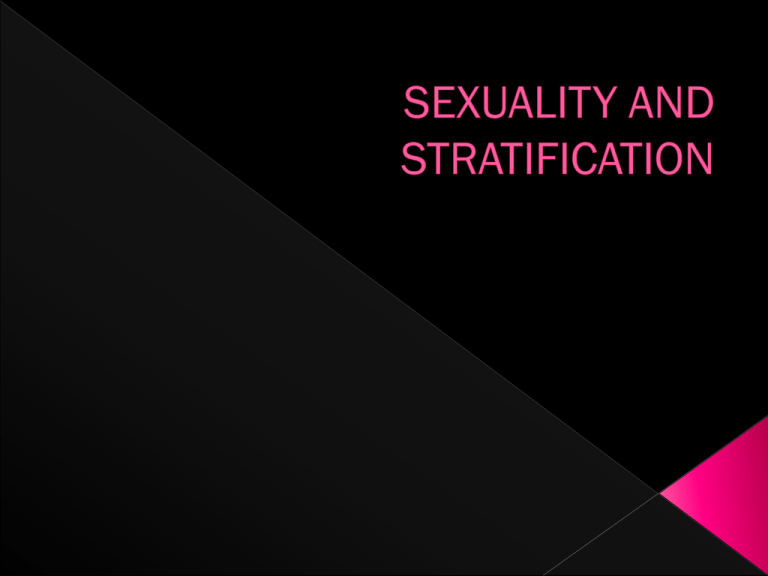
DO NOW: Answer the following questions in your
notebooks.
› What does “gay” mean in this phrase?
› What negative adjectives does “gay” tend to describe?
How does the routine negative use of the word inherently
socialize us towards participating in stratification?
Lesbian- a woman who is attracted to and/or forms
intimate relationships with other women.
Gay/gay man- a man who is attracted to and/or forms
intimate relationships with other men.
Bisexual- an individual who is attracted to and/or forms
intimate relationships with both men and women.
Transgender- an individual who lives either part or full
time as a member of the opposite gender. These individuals
may be heterosexual, homosexual, or bisexual. This
includes transvestites (cross-dressers) and transsexuals
(those who choose to live as the opposite gender of his/her
genetic sex at birth, independent of whether he/she
undergoes sex reassignment surgery).
Queer- An umbrella term to refer to all LGBTI people
› A political statement, as well as a sexual orientation, which
advocates breaking binary thinking and seeing both sexual
orientation and gender identity as potentially fluid.
› A simple label to explain a complex set of sexual behaviors
and desires. For example, a person who is attracted to
multiple genders may identify as queer.
› Many older LGBT people feel the word has been hatefully
used against them for too long and are reluctant to embrace
it.
Intersex- individuals with medically established physical
or hormonal attributes of both the male and female gender.
These include those born with Turner Syndrome and those
that live as hermaphrodites.
Sexual orientation is considered to have three
dimensions:
1. Desire/attraction
2. Behavior
3. Identity
Just because someone has had sex with a person of
the same gender does not mean that they are
inherently “gay.”
Human sexual attitudes and behavior vary in
different cultural contexts.
Sexual attitudes and behavior change over time.
Sexual identity is learned.
Social institutions channel and direct human
sexuality.
Public policies regulate sexual and reproductive
behaviors.
Associated lesbianism with insanity, arguing that
professional women emerging during the 1920s and 1930s
were prone to this “disease.”
Ellis regarded anything but heterosexual, monogamous
sexuality as “sexual deviance.”
› Ellis’s ideas show how social stereotypes about homosexuality can
pervade even seemingly scientific studies of sexuality.
The first major national surveys of sexual behavior
published in the 1940s and 1950s.
Kinsey’s research was based on a national sample of 11,000
interviews, but all the research subjects were White,
relatively well-educated, and middle-class.
All the interviewers and staff members were White,
heterosexual, Anglo-Saxon, Protestant men.
Even with bias in the sample, the Kinsey reports were the
first comprehensive, nationally based studies of sexual
practices.
Kinsey was first to report that 33% of women and 71% of
men engaged in premarital sex despite public belief to the
contrary.
› Surveys show these figures have grown to 70% of women
and at least 80% of men.
Kinsey reported that 37% of men had experienced
consentual homosexual contact at some point in their lives.
SO…WHICH IS IT?
The gay “gene”?
Maternal heritability
Xq28
33 of 40 gay brothers shared the same gene in the same
region on the X-chromosome
Downfalls?
There’s no evidence for genes other than Xq28
that affect homosexuality
Study only found in gay men…what about
lesbians?
•
Simon LeVay (1991)
Neurobiologist at the Salk Institute in La Jolla
California, Published in the Journal Science
The third interstitial nucleus (located in the hypothalamus)
is normally larger in men than in women
in his sample of gay men, the third interstitial nucleus was about the same size
as in women
Hypothalamus plays a role in sexual motivation
Handedness
› Lesbians are 91% more likely to be left handed than heterosexual
women.
› Gay men are 34% more likely.
Index (pointer) and ring fingers
› Women: the length is more similar than in men (men: bigger difference
in the length of these two fingers)
Caused by exposure to male hormones in utero
You can see this difference at age 2
› Lesbians: the difference is more similar to men
› Suggests that lesbians may have had a greater exposure to male
hormones in the womb
”Fraternal Birth Order Effect" - James Cantor, et. al
› The more older brothers you have, the more likely a male is
to be gay
It doesn't matter what the sexual orientation of the older brother is
Not true if your older brothers are step brothers or adopted
Confirmed across cultures
No relationship found for lesbians
› Explanation: a change in the hormonal balance in the
mother's uterus with each additional child.
Downfalls to study?
Could this help to prove environment rather than
biological factors?
TWIN STUDIES
› Types
Dizygotic twins
“fraternal twins” - two eggs, so they don't look alike
22% of twins of gay males were also gay
16% for lesbians
Monozigotic twins
"identical twins" (one egg)
52% of the identical twins of gay males were also gay”
48% for lesbians
Downfalls to the study?
Not a perfect correlation—argues that it cannot be
purely genetic.
TWIN STUDIES, cont.
› Focus: identical twins raised apart
Same genes, different environment
If identical twins raised apart are both gay, that argues for a genetic
influence
Results: Roger Hock-"quite consistent”
Higher, for example, than if the twins were dizygotic
Downfalls to the study?
Even twins raised apart are not likely to be raised in very
different family environments
Necking and rubbing to sexual excitement is common
among male giraffes
Common among pygmy chimpanzees
Greylag geese can have homosexual unions that last up
to 15 years
Childhood Experiences
› Research by Bell, Weinberg & Hammersmith (1981)
› "..conducted face-to-face interviews with 979 homosexual
participants (293 women and 686 men) and 477 heterosexual
controls. The researchers found no single condition of family life
or childhood experience that in and of itself appeared to be a
factor in either homosexual or heterosexual development."
Influence of Gay Parents
› Patterson, C.J. (2000). Family Relationships of Lesbians and Gay
Men, Journal of Marriage and Family, 62, 1052-1069
› Mikach interviewed 75 gay fathers - only 7 of their sons identified
themselves as gay.
“... no significant problems in the development of sexual identity
among children of lesbian mothers have yet been identified” - p.
1060
“...gay men are no more likely than heterosexual men to perpetrate
child abuse (Jenny, Roesler, & Poyer, 1994). Fears that children in
custody of gay or lesbian parents might be at heightened risk for
sexual abuse are without empirical foundation” - 1060-1061
Zach Wahls
Specific factors that have been linked with homosexual
behavior:
Poor family dynamics
A rift in the father-son or mother-daughter relationship
growing up
Feelings of being an outsider among one's peers during
childhood and adolescence
Instances of sexual abuse/incest
Roger Hock- explanations for homosexuality:
› Homosexual men have overly protective mothers and distant
fathers and homosexual women had overly protective fathers and
distant mothers
› Homosexuals were molested as children by a same sex adult (The
so-called "seduction hypothesis")
› Homosexuals are more likely to have had a gay mother or father no evidence that homosexuality is more likely when children have
gay parents
Downfalls to the study?
Possible confirmation bias: how many heterosexual men do you know
who have a distant father and protective mother? We often don't even
think about looking at this
The weakness of doing a survey on this issue: even if you find
support - which one is the causal factor? Did the parents cause the
child to be gay, or did the child's homosexuality cause the parents to
act this way?
Wood, Wood & Boyd: The World of Psychology
› "Clearly there are no certain predictors of homosexuality”
Brian Gladue
› "The presence of biological factors in the development of homosexuality (and
heterosexuality) is becoming increasingly obvious. Already we have a set of
reliable findings, from many laboratories, demonstrating that human sexual
orientation has a genetic basis....”
› "...not all men and women arrive at their sexual orientation following the
same path.”
The continuum: back to where we started
› The danger of black/white, gay/straight thinking. We're all along that
continuum somewhere.
› For some, their orientation was influenced by hormones in the womb, others
by events in their childhood.
Current Accepted Theory:
› Your biology gives you a pre-disposition to
certain qualities
› You need the environment to “trigger” and
“out” these qualities
Definition: the fear and hatred of homosexuality.
Produces myths about gay people such as:
› Gays have a desire to seduce straight people.
› Gay and lesbian parents will have negative effects on
their children.
› They are mostly White men with large discretionary
incomes who work primarily in artistic areas and
personal service jobs.
MAIN REASON OF SOCIAL STRATIFICATION
› At times homophobic beliefs lead people toward prejudiced
actions at work, at schools, at clubs and in many other areas
as well.
› Prejudiced views directed at homosexuals often stem from
the perception that homosexual activity is immoral.
› Homophobia makes some people think that they are
superior to homosexuals.
***Note*** Studies show that anti-gay bias is far more
accepted among large numbers of Americans than is bias
against other minorities.
Self Hate
Teenage Suicide
› Researchers Remafedi, Farrow, and Deisher compared gay and bisexual
adolescents who had attempted suicide, to a group of those who had not. The
two groups totaled 137 males, aged 14 to 21. Of that number, 41 (30%) had
made at least one suicide attempt.
Among the Remafedi study's findings:
1.
2.
3.
4.
5.
6.
7.
8.
Early Self-Identification as Gay: Subjects who had viewed themselves as
homosexual or bisexual at an earlier age were more likely to attempt suicide.
Early Sexual Activity: Teens who had attempted suicide were more likely to have had
sexual experiences at an early age.
Broken Homes: Only 27% of suicide attempters had parents who were married (vs.
50% of the non-attempters).
Sexual Molestation: 61% of the suicide attempters had been sexually abused (vs. only
29% of the non-attempters).
Illegal Drug Use: 85% of the attempters had used illicit drugs (vs. 63% of nonattempters).
Illegal Activities: 51% of the attempters had been arrested (vs. only 28% of nonattempters).
Prostitution: 29% of the attempters had been involved in prostitution (vs. 17% of
non-attempters).
Gender Conflicts: 36.6% of the attempters were classified as feminine (vs. 17.7% of
non-attempters).
Hate Crimes
› LGBTI high school students have been threatened with a weapon at a rate four
times that of heterosexual high school students.
› While 10% of heterosexual teens reported attempted suicide, 40% of LGBTI
teens reported suicide attempts.
1.
2.
3.
4.
5.
6.
7.
DSM II (“Gay”) (1973)
Gay Male Blood Donations
Ben-Shalom v. Stone, Woodward v. U.S. (1990)
Matthew Shepard/Tyler Clementi
Massachusetts Marriage Ruling (2004), Gay
Marriage vs. Civil Unions
Don’t Ask Don’t Tell Ruling, Controversy
Media Images – Positive and Negative

